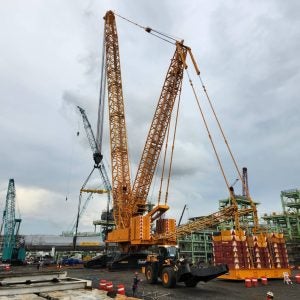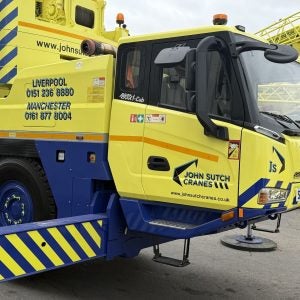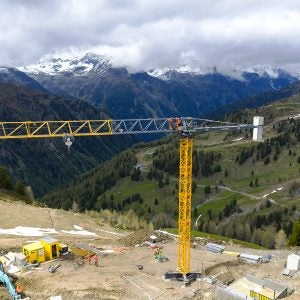Crawler cranes with hydraulic telescopic booms are not a new concept. They have been around for 30 years, but have always remained a niche product, offered by just two or three manufacturers. Until now, that is. In recent years interest in the product has grown to the extent that at least eight companies are now producing telescopic boom crawlers, and that’s not including the sub-10t capacity mini cranes from Japan.
Telescopic boom crawler cranes, or telecrawlers, have the go-anywhere ability of crawler cranes coupled with the quick set-up of a telescopic crane. Crawler tracks mean low ground bearing pressure and the ability to get up close to the load; a telescopic boom means the flexibility to get under overhead obstructions. The result is that a telecrawler can often replace a much larger wheeled crane or lattice boom crawler.
Telecrawlers typically have less onerous maintenance requirements than the rough terrain mobile cranes they are most likely to replace. Many have hydraulically retracting crawler tracks for ease of transport when retracted and maximum stability and lifting power when extended.
Traditionally, telecrawlers were targeted primarily at utility companies and power line contractors, but increasingly they are entering the fleets of general crane rental companies as an alternative to a rough terrain, doing general duties on all kinds of construction sites. And this growth in popularity comes at a higher sticker price.
Production history
The trailblazer in this product segment is SpanDeck of the USA, which has been producing the Mantis range of tele-crawlers since 1979. It has ploughed a lonely furrow over the years as a small company making cranes in low volumes. Certain prestige projects raised awareness of Mantis, such as the Boston Big Dig highway scheme in the 1990s, where the cranes were able to work inside the cut-and-cover tunnels..
The past couple of years have seen strong demand for its products and, with a new factory in Virginia, output has grown considerably and the product range has been extended at the top end with the addition of a long-awaited 100 US ton (90t) model. Called the 20010, the new model has a 39m four-section boom with a 9.1m swingaway extension and a 9.1m swingaway fly jib. Mantis owner Bill Mitchell has been promising this model for years but says that the company’s limited resources were always too stretched simply meeting demand for existing models. The first two units of the 20010 were finally delivered to Texas-based dealer Scott-Macon in April.
Mantis has now begun planning a 125 US ton model, Mitchell reveals.
Another company that has offered telecrawlers for many years is Bendini of Italy, part of the Terex group. It introduced its first model in 1995, a 50- tonner. In 2006 it introduced a new three model range of the TCC40, TCC45 and TCC60, rated at 40t, 44t and 60t respectively. The company says that the introduction of the new models was driven by demand in Italy, Belgium and Spain in particular.
Sennebogen of Germany has also offered cranes in the telecrawler niche for a few years. It offers three models: the 613, rated at 16t with 18.8m of boom and a 5m jib; the 643, rated at 40t with 30m boom and 13m double folding jib; and the 683, rated at 80t with 42m boom and 17m jib.
Favelle Favco, the Malaysian-owned tower crane manufacturer, set up an enterprise in the USA in the late 1990s to build telescopic crawler cranes using Caterpillar excavator base units. Production was shelved in the depths of the recession five years ago and currently looks unlikely to resume. A few units are still available ex-stock, however.
Several new entrants have joined the market recently. In 2005, Liebherr introduced the 100t-rated LTR 1100, using the upper section and 52m boom of the LTM 1100-4.1 all terrain and the base unit of the LR 1100.
Liebherr had previously made a single unit of an 800t telecrawler, the LTR 1800, for a customer in Asia, but the LTR 1100 is its first series model. It now produces 30 units a year.
On the drawing board at Liebherr and scheduled for launch next year is an LTR 11200, featuring the upper of the 1,000t-capacity LTM 11200-9.1, with its record-breaking 100m boom, mounted on the narrow-track crawler base unit of the LR 1350. Unlike regular telecrawlers, however, it will only be able to lift with outriggers deployed.
Liebherr says it is producing around 25 to 30 units a year of the LTR 1100, and is experiencing higher demand than it had expected. “The best markets are the Middle East (mainly Saudi Arabia and UAE), North America and Australia,” says marketing manager Wolfgang Beringer.
In the same year that saw Liebherr bring out the LTR 1100, Hitachi-Sumitomo launched the SCX 400T, rated at 40t, to follow the 8t-rated ZX160LCT mini telecrawler of the previous year. This model is put together by Hitachi Construction Machinery Europe (HCME) in the Netherlands using a 40m boom shipped from Link-Belt in the USA and a base unit from Japan.
This model was soon picked up by Sumitomo’s US subsidiary Link-Belt. It was renamed the TCC-450 and given some minor modifications, with a bigger cabin and joysticks replaced by single-axis controllers. An offsettable fly jib has also been made available recently.
Meanwhile, in Italy, Marchetti produced the Sherpa CW 65.42L, rated at 65t and with a 42m telescopic boom, with outriggers to be deployed for lifting.
Working with Marchetti was Dutch dealer CraneBusiness, which had made its name trading lattice boom crawler cranes. CraneBusiness is Marchetti’s distributor for this model in the Netherlands.
The Dutch firm has now gone a step further and begun producing its own range of telecrawlers under the brand name Logicrane.
After building a single 15t unit, now in its rental fleet, CraneBusiness subcontracted production of the 25t-rated model 25.25 to an undisclosed company in China. A first run of five units was shipped last year and a second series of five is now on order. In May this year it launched the Logicrane 55.38-55t capacity (50t at 3m radius) and 38m boom. This model is also built in China, by Fushun Excavator, although as CraneBusiness takes responsibility for the CE certification process necessary in the European Union, it is legally identified as the manufacturer. An initial two units of the 55.38 have been produced. Standard features of the Logicrane series include a cabin that can be raised and tilted, two winches and detachable counterweights.
Why buy?
CraneBusiness director Hemmo Luijerink says that crane users are starting to realise the benefits of the telecrawler. “We believe it is the future,” he says. “People are starting to recognise the concept. In the past it used to be expensive. Now, our price is about equal to a lattice type.”
He adds: “There is a tremendous population of 40t and 50t crawler cranes with short booms of 30m to 40m. They need replacing. For pick and carry jobs on site the telescopic crawler is much more versatile.”
Bill Mitchell says that the rise in demand for Mantis cranes can only be partly explained by the general health of the crane market. Over the years, Mantis has lost potential sales because of the ready availability of new and used lattice boom crawlers. A new Mantis is 10%-15% more expensive than an equivalent lattice boom crane, he says. For the past couple of years there has not been the same kind of availability for cranes, either new or used. But with larger manufacturers now promoting the concept, demand for telecrawlers is now growing faster than the overall market, he says.
Mitchell estimates that total deliveries of telescopic boom crawler cranes this year, by all manufacturers, might be in the region of 250 units. It is not a big market, therefore, but it is probably five times what it was five years ago. By comparison, the wheeled mobile crane market has only doubled between the bottom of the market in 2003 and what might prove to be the top in 2008.
Of Mantis, Mitchell says: “Since 2003/04 we have grown incredibly fast. The problem is we cannot fill the demand right now”. Components are hard to source for such a small company with not much purchasing power. “We are pretty much at the back end of the supply chain. Precision machine parts are extremely hard to come by,” he adds.
It is not just the small companies that struggle to meet demand. Link-Belt relies on units being shipped from HCME, which in turn relies on base units being made available by Hitachi-Sumitomo in Japan. “We can’t get enough of them, that’s the problem,” says Link-Belt product manager Pat Collins. “We have none available. Everything is working or sold.”
While Link-Belt had faith in the product, it has clearly been a little surprised by how interest has snowballed. Collins says: “We tended to think it would go to utilities and power line companies, that kind of work. We were eyeing that kind of market but also had an idea the general crane rental companies would want it too. However, it has been a bit of a surprise the extent to which they’ve gone to general rental.” This is despite the fact, he says, that the TCC-450 is more expensive that a comparable size RT or lattice crawler and so requires a higher rental rate.
Instead of relying on HCME and Japan, Link-Belt is now developing its own larger telecrawler, designed and built in Lexington, Kentucky, and scheduled for launch next year. Unlike most other machines on the market, it will be designed from the ground up specifically to be a telecrawler, Collins says, rather than a mix and match of an established crawler base with a telescopic boom attached.
This is a point that Mitchell has always claimed gives the Mantis cranes inherent superiority over the hybrids offered by others. He describes other telescopic crawler cranes on the market, which take a telescopic boom upper from a rough terrain or all terrain and mounting it on crawler tracks, as “hybrids”. While recognising the manufacturing efficiency benefits, Mitchell says this approach compromises the performance.
The UK is another market that is starting to be seduced by the telecrawler. Dougie McGilvray owns the country’s largest fleet of crawler crane for hire, Weldex. Out of his total fleet of 118 crawlers, six of them are the telescopic boom type: an 80t Mantis, and five Sennebogens. Three more Sennebogens are now on order. “I think the proportion [of telescopic crawlers in the fleet] will increase because they are getting very popular,” says McGilvray.
NRC Plant is the UK and Ireland dealer for Hitachi-Sumitomo and Link-Belt, and also runs a crawler rental fleet. Director Rod Abbot says that there are approximately 20 units of the SCX 400T in Europe so far and about the same number of the 8t capacity ZX 160LCT, all in just three years. “They are taking off in the UK,” he says. He has five SCX 400Ts in his rental fleet and has sold more than a dozen to contractors. A further five are on their way to him, he says. “At first it was slow but it’s picking up now. In the next five years you will see an explosion, I predict,” Abbott says.
“I’ve lent it to people free of charge and they’ve realised you don’t have the rigging costs of a lattice crawler, which is quite significant. And if you are in London and you have to build the jib, where are you going to do that?”
Such has been NRC’s success with the SCX 400T, it wants to expand the range of telecrawlers in its fleet by adding a 25t capacity machine. With none available through Hitachi-Sumitomo, NRC has signed up as UK and Ireland dealer for CraneBusiness’s 25t Logicrane.
Abbott says he now wants to add a larger model. “A lot of my clients are saying ‘have you got a bigger one?’. I will have soon.” He hopes to buy the first two units of Link-Belt’s forthcoming telecrawler, which he expects to be in the 70t or 75t class.
Other manufacturers have also noticed that general crane rental companies are increasing looking towards the telecrawler. Sennebogen sales director Bernhard Kraus says: “In general customers are getting more and more sensitive for cost saving and flexibility. That is certainly one of the reasons why interest in telescopic crawlers is permanently increasing worldwide. Nowadays more and more the classical crane rental companies have added crawler telescopic cranes to their fleet as well.”
According to Bill Mitchell, the telescopic boom crawler crane is “a concept that has come of age”. He welcomes the arrival of competition from major players like Link-Belt, Hitachi-Sumitomo and Liebherr, all putting their weight behind validating the concept and only wonders what took them so long to catch on.
He concludes: “I believe this market is emerging and the possibilities are limitless. The pie is getting bigger and bigger and there’s plenty of room for everyone.”






